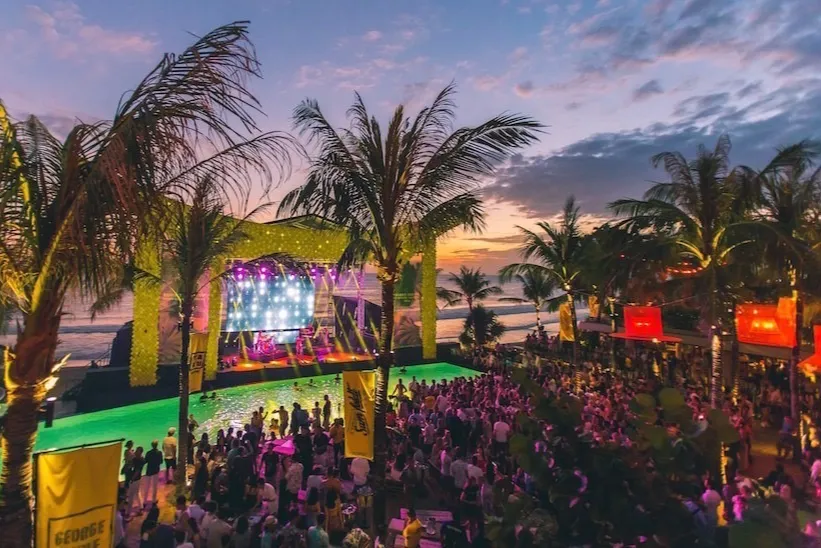In the book Small Acts of Repair: Performance, Ecology, and Goat Island, Karen Christopher, a member of now-defunct performance group Goat Island, describes the performance group’s work as such: “What we try to do is create a history within a span of time and among a group of people sharing an experience.” To do so, they “facilitate a breakdown at the beginning of the performance—to pull spectators away from wherever they have been… and to bring them into this space, now.”
As I wait for Drama Box’s Air to begin, the atmosphere is one of an ordeal already over. The audience is positioned on two sides of a curved, largely empty platform, which echoes the curve of an absent boat. A blinking emergency light and the absence of house music means we wait silently with this invisible wreck. Disaster has come and gone, and we’re looking at what remains. Rather than staging a breakdown to draw us in, Drama Box invites us into Air through the aftermath of loss.
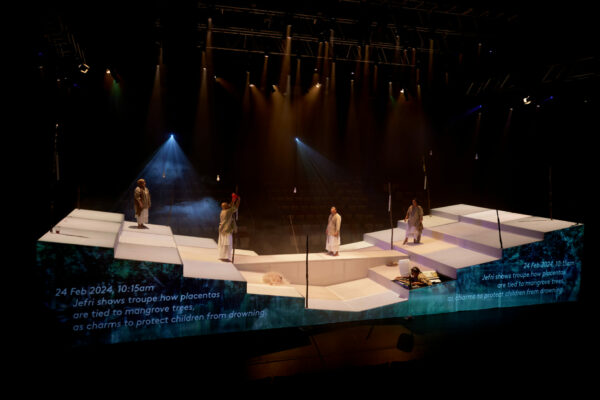
Air is a verbatim play which shares the voices of the Orang Seletar, an indigenous coastal community that once lived in Singapore. The performance begins with a scene of the four performers — Dalifah Shahril, Rizman Putra, Saiful Amri, and Suhaili Safari — studying the characters they are meant to portray. It is a thoughtful frame, a way of acknowledging their role as conduits rather than direct representations of the Orang Seletar. As articulated by Christopher, a performance doesn’t simply depict, blow by blow, a definite and established history. It creates a history of its own. In telling the histories of other people, it is vital to acknowledge our hand in the narrative.
Intricate and beautiful scenes of the Orang Seletar’s stories are intermingled with scenes depicting the performance troupe’s research process, which involves a visit to the Orang Seletar community. The stories of the Orang Seletar span sharings about their daily lives and relationships, as well as their relationship with the sea. They tell of the way land has encroached upon the sea, and how the clearing of mangrove forests has driven them away from their homes. The delicate delivery of the performers gives the stories a sense of intimacy, tenderness, and honesty.
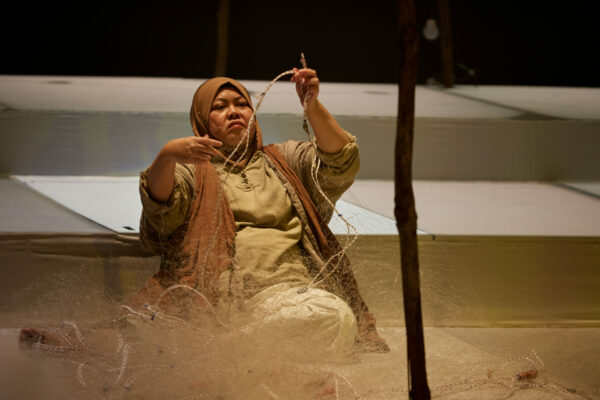
What emerges most sharply is an abrasive, unequal relationship between land and sea, which also echoes relationships between ownership and dispossession; Orang Seletar and Malay languages; being documented and undocumented. As numerous stories reflect, land is the place where people go to school and become documented through birth and marriage certificates. Land is where one “becomes Malay”. Land is where one has power. The sea, which is amorphous, fluid, and hard to measure and document, is pushed away. Both options are difficult. To stay with the sea is to endure the slow violence of being ejected from the demarcations of land. To go to land is to “be influenced”, and to “become extinct”.
The intermingled scenes depicting the performance troupe’s experiences during their visit remind us of the subjectivities of the performers. We are not simply entering the stories of the Orang Seletar; we are seeing them through the interpretations of these artists. By depicting their interactions with the Orang Seletar community, the performers invite us to experience their own curiosity and playfulness in that environment. We are invited to see through their eyes, which look upon these stories and people with love.
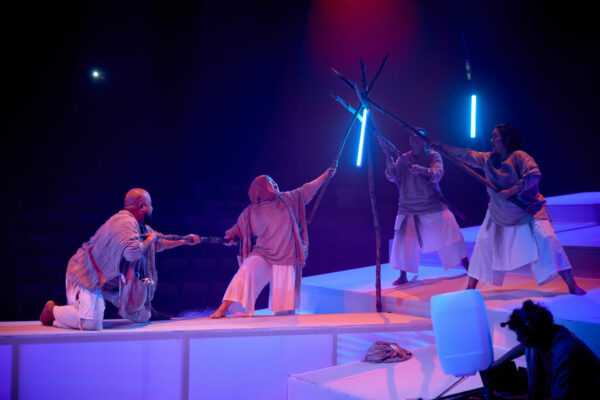
The design of Air is incredibly tasteful and nuanced. From the elegant and atmospheric lighting design by Emanorwatty Saleh, to the ever-sophisticated costumes by Max Tan, the performance is a sensory pleasure. So many standouts to name: the evocative live performance of sound designer and musician Tini Aliman; the imaginative set design of Mohd Fared Jainal; and nuanced work of multimedia designer Jevon Chandra.
Aliman’s presence on the stage reminded me of the embodied nature of music, which I’ve missed in my hours of Spotify. It was moving to see Aliman’s body at work in producing the sonic landscape of the show. It was also no small joy to see the initially opaque platform reveal itself as a translucent depth, into which performers lowered themselves and shone lights through as though underwater — a magical surprise.
As for the multimedia design, the surtitles and informational texts projected on the platform are what stood out. Rather than showing up plainly, these texts operated more like poetic verse — occurring as indented fragments. Some fragments lingered as new text appeared, allowing what was newly said to collaborate with what had been said before. As text repeated, lingered, and was censored through blackouts (à la blackout poetry), adjacent meanings and readings emerged, too fleeting to be captured.
Due to the heavy use of these surtitles and informational texts, the performance became not only an experience of watching and listening, but also one of reading. As a writer, I relished this playfulness and nuance. I loved how it echoed the constellation of stories unfolding on stage. However, the complex experience of reading at times interfered with the simplicity of Air’s stage images as well as its profound, unspoken emotions. It was easier, after a while, to let the words wash over.
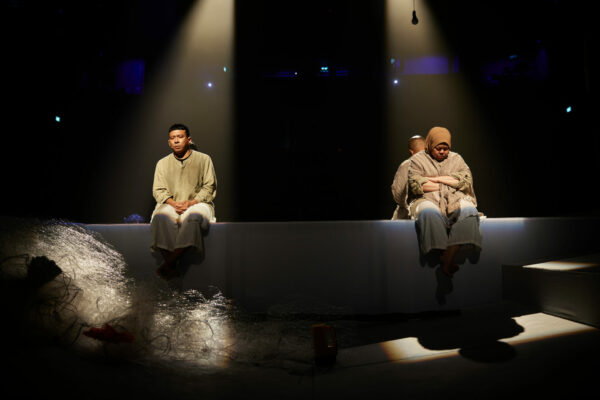
If there’s anything I felt uncertain of, it was the mixture of organic (“real”) elements such as fishing nets and the soft shapes of the costumes, with more stylised (“artificial”) elements such as the set and the texts. I wonder if a greater commitment to either aesthetic would have allowed the stage images to go further, particularly in developing a clearer progression over the course of the performance.
Perhaps I’m asking for too much from a production that’s already this beautiful and intricate — but I found myself wanting a greater sense of change or accumulation from the visual aspects of the performance, one which goes beyond the final change of the performers into black, modern clothing to mark a final departure from the Orang Seletar. Perhaps what the stories left me with was a desire for regeneration and repair.
Ultimately, Air is a beautiful, intricate piece of theatre. The tender and thoughtful work of co-directors Adib Kosnan and Kok Heng Leun, as well as playwright Zulfadli Rashid, shines here. Dramaturg Charlene Rajendran and researcher Ilya Katrinnada also deserve credit for the rigour and sensitivity of the play, which allows a familiar story of loss to be told anew, with incredible heart.
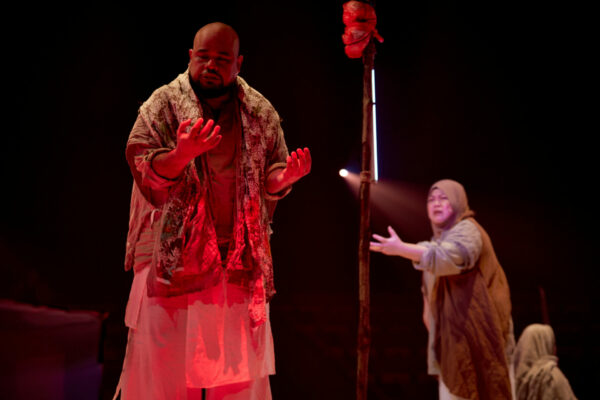
Air by Drama Box
Presented as part of The Studios by Esplanade — Theatres on the Bay
Date: Fri, 12 Jul 2024 – Sun, 14 Jul 2024
Time: Fri, 8pm / Sat, 3pm & 8pm / Sun, 3pm
Venue: Singtel Waterfront Theatre at Esplanade
Review is done with author’s discretion. Photos by Crispian Chan, courtesy of Esplanade – Theatres on the Bay.






